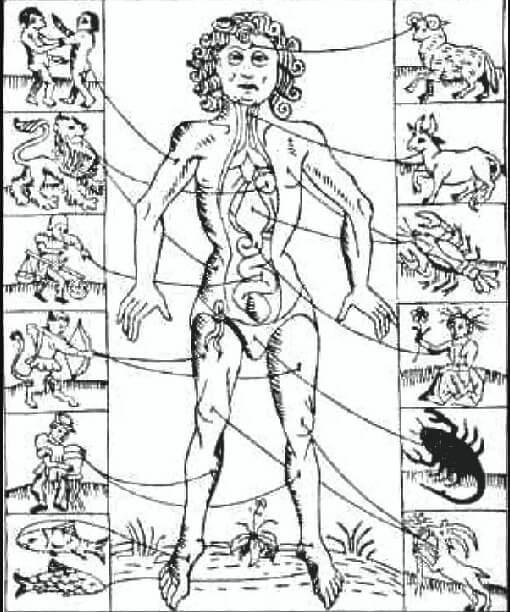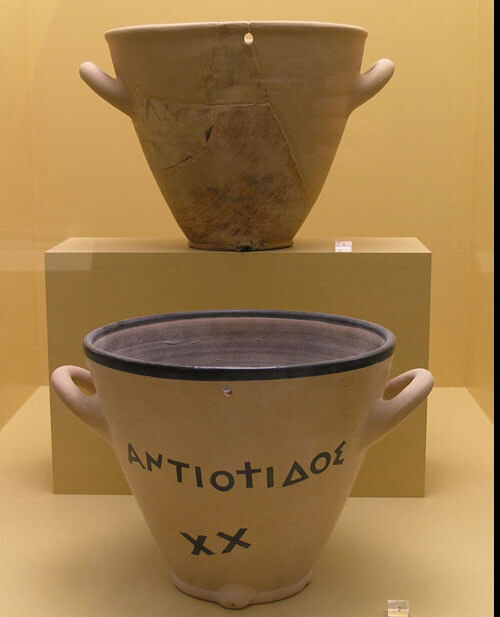Ancient civilisations assimilated the heavens into the pantheon of their gods. At its height, astrology permeated religion, science, philosophy and all human activity. Observing the stars formed the basis for the measurement of time, which was gradually organised in the form of the calendar. Man thus forms part of the Cosmos, both physically and intellectually.
The “Celestial Man” is at the origin of all connections made between heaven and man, medicine and astrology. Each part of this celestial figure was thought to be influenced by waves emitted by a planet whose rays, transmitted in the same instant to the human body, increased the effectiveness of medicine. The “Celestial Man” became the “Zodiac Man”, whose body was divided by astrologers into 12 parts corresponding to the 12 sectors of the zodiac (the 12 houses of heaven). Physicians then drew a silhouette showing the points at which the patient should be bled, attributing Aries to the head, Taurus to the throat and nape of the neck, Gemini to the shoulders and arms, and so on.

Stones as medicine
In parallel, the special rays emitted by a star were believed to act even as the different types of medicine were being prepared, i.e. when the plants were being gathered and minerals sought. Each plant and each rock contained a predominant component, which was under the temporary influence of the ruling heavenly body at that time. This influence affected the efficacy of the remedy at the moment of its preparation, and even more so at the time of its use. Medical astrology thus attributes a particular planet to each plant and stone used in the preparation of medicines.
The Ruby is linked to the Sun (Sunday). It provided protection from the plague and revived victims of fainting fits. Ground up and mixed into a hot drink, it was also used as a remedy against haemorrhages. Louis XIV took enormous quantities of rubies during the illness that eventually led to his death. As for Isabella of Bavaria, she demanded that her rubies be crushed and mixed with pearls to overcome her obesity. History does not relate what the outcome of this treatment was. Another example is Rock Crystal, which was associated with the Moon (Monday). Ground up and mixed with wine, it was used as a remedy against dysentery for a long time in England.
Introduction of the calendar day
Over the course of time, medicine evolved independently of cosmology, which, in the end, only controlled the times at which interventions were carried out and medicines taken. The Greeks and Romans turned medicine into a technical art. In the 3rd century BC, the physician Herophilus found that the pulse and the movements of the heart were synchronous. Using a clepsydra or water clock, Herophilus (and others that followed him, right up to the Middle Ages) were thus able to measure fevers and heartbeats.
Originally, priests took control of astrology, followed by kings, and finally the people themselves through traditions and observations that were passed on from generation to generation. In the 14th century, astrologer-physicians became more influential and introduced the calendar day and the division of the day into two periods of 12 hours, replacing the natural day and canonical hours. It is around this period that the mechanical clock was developed. Clocks were very rapidly set up in town halls and integrated into city gates, palaces and religious buildings. Some also provided additional astronomical and astrological information. The “Zodiac Man” appears in almanacs and also on certain clocks such as those at Strasbourg (1354), Mantua (1473) and Munster (1500), indicating the appropriate time to administer remedies and perform blood-letting and surgical interventions.

From the pendulum to the pneumograph
During the Renaissance, Girolamo Fracastoro, the Pope’s special physician, accompanied the Pope to the Council of Trent, where the decision to reform the calendar was taken. Galileo Galilei, a doctor, physicist, astronomer and philosopher, recommended the use of the pendulum to measure fevers and heartbeats. To this end, he constructed a special instrument which he called the “pulsilogus”. Newton, Descartes, Huygens and other scholars compared the organs of the human body to the components of a watch or a clock. The considerable progress made during this period in the construction of chronometers gave watchmaking a huge boost. Following the pendulum that beat out the seconds, pocket watches were fitted with seconds hands. This advance enabled the English physician Sir John Floyer to create his pocket sphygmomanometer in 1705 for the measurement of arterial blood pressure.
Over the 19th and 20th centuries, the medical community turned to the watchmaking industry for the creation of instruments that offered ever more precise control and measurement. Pneumographs and pulsometers, used firstly as pocket instruments and then worn on the wrist, started to be employed in clinics and hospitals. The pneumograph was a chronograph with an asthmometer scale, which enabled the number of respirations per minute to be determined. The doctor released the needle of the chronograph at the moment that the patient began a respiration, and stopped it after the 5th, 10th, … or 25th respiration, depending on the scale indicated on the dial. The needle showed directly the number of respirations per minute. Using an identical procedure, the pulsometer determined the number of heartbeats per minute. By this stage, we had come a long way from the “Celestial Man” and the magic of the stars, stones and divinities. But where our health is concerned, no-one is complaining!












